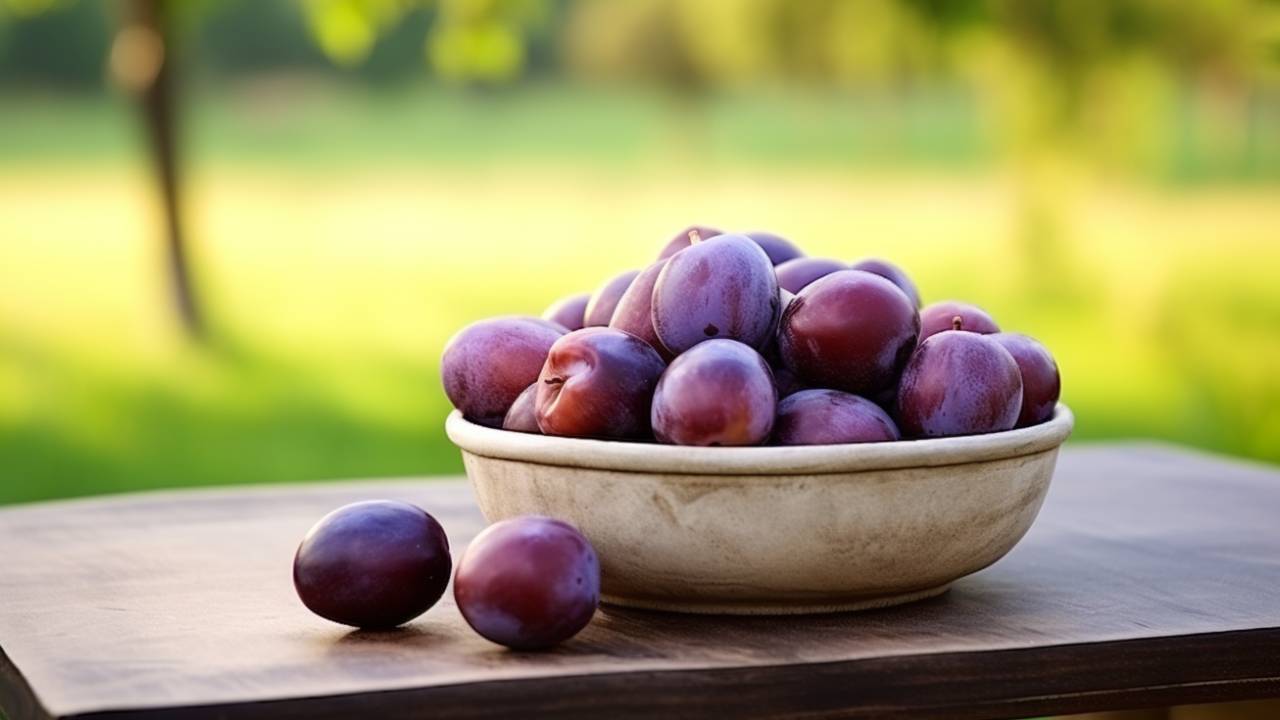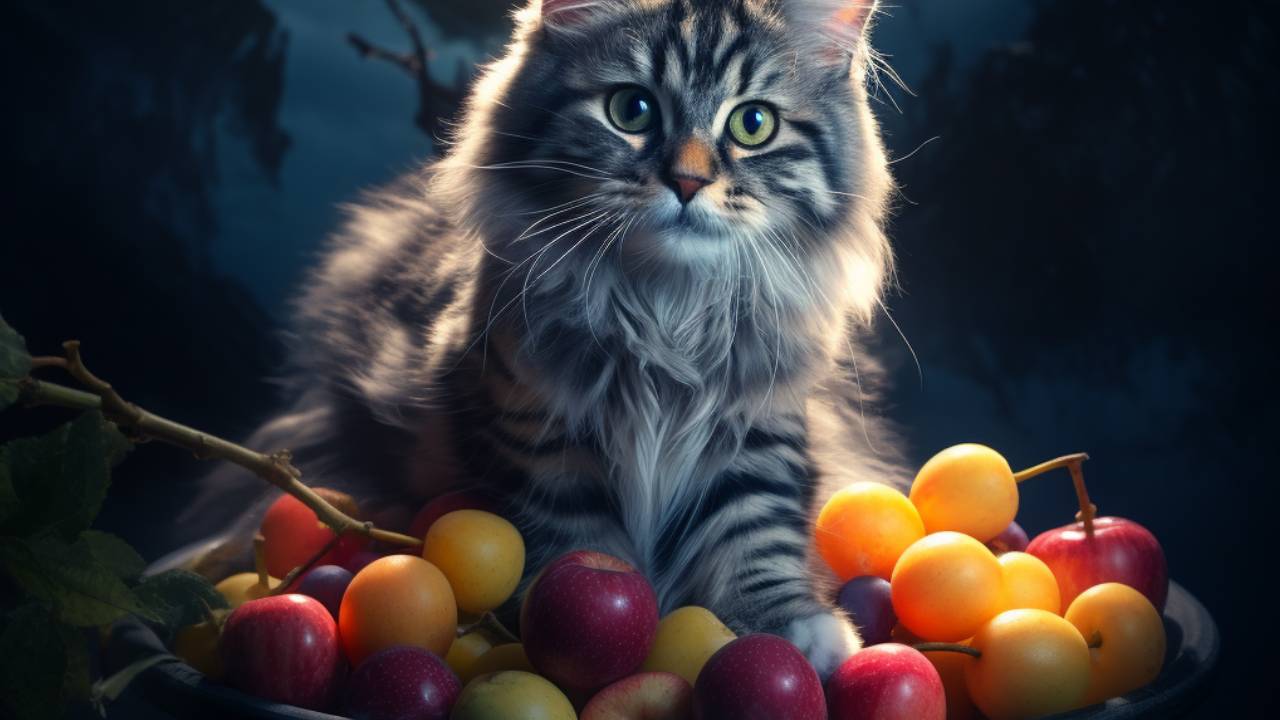Is it okay for cats to eat plums? The short answer is no. Cats should not eat plums. Despite seeming harmless, plums can pose some health risks to a cat. Let’s also examine why they are bad for your cat and why you shouldn’t introduce them into your friend’s diet.
Are Plums Safe For Cats?
No, plums are not safe for cats. Plums contain cyanogenic glycosides, which can break down into cyanide when ingested. Cyanide is highly toxic to cats and can lead to severe health problems.
While small amounts of plum flesh may not be immediately toxic, it’s best to avoid giving plums to your cat altogether to prevent potential health risks.
If you suspect your cat has consumed plums, it’s essential to contact your veterinarian for guidance and potential treatment.
Why Are Plums Bad For Cats?
Plums are considered bad for cats for several reasons:
- Cyanide Content: Plums contain cyanogenic glycosides, which can break down into cyanide when ingested. Cyanide is highly toxic to cats and can have severe health consequences.
- Allergic Reactions: Some cats may be sensitive or allergic to plums, which can result in adverse reactions. These reactions might include itching, skin rashes, or gastrointestinal issues like diarrhea and vomiting. These discomforting symptoms can be distressing for both you and your cat.
- Digestive Upset: Plums are high in sugar, and consuming them can lead to digestive upset in cats. This may manifest as diarrhea or vomiting, which can be uncomfortable for your feline friend.
- Choking Hazard: The plum pit or stone is another reason plums are bad for cats. If your cat ingests the pit, it can pose a choking hazard. Even if the pit is not swallowed whole, it can cause intestinal blockages if lodged in the digestive tract.
- Unnecessary Sugar: Plums are naturally high in sugar, and excessive sugar consumption is unsuitable for cats. It can lead to obesity, diabetes, and dental problems over time. Cats are obligate carnivores; their primary dietary requirement is meat, not sugary fruits.
Can Plums Kill My Cat?
Yes, plums can potentially kill your cat, although it would typically require a significant amount of plum ingestion for this to occur. The primary concern is the presence of cyanogenic glycosides in plums, which can break down into cyanide when metabolized by your cat’s body.
Cyanide is a highly toxic substance that interferes with the body’s ability to use oxygen, leading to severe respiratory distress and, in extreme cases, death.
Cyanide Poisoning in Cats After Plum Ingestion
Cyanide poisoning is a rare but severe condition, and the symptoms can develop rapidly. If your cat ingests a large amount of plum flesh or consumes the pit, it can increase the risk of cyanide poisoning. Common signs of cyanide poisoning in cats include difficulty breathing, seizures, dilated pupils, and lethargy.
Suppose you suspect your cat has ingested plums or is showing any of these symptoms. In that case, it is essential to seek immediate veterinary attention to provide the necessary treatment and increase the chances of a positive outcome.
To ensure your cat’s safety, it is best to avoid giving plums to your feline companion altogether and opt for safe and cat-friendly treats and foods recommended by your veterinarian.

What Should I Do If My Cat Has Eaten Plum?
If you suspect your cat has eaten plum or any other potentially harmful plant, taking immediate action is crucial to ensure your cat’s safety. Here’s what you should do:
- Contact Your Veterinarian: The first step is to immediately call your veterinarian or an emergency veterinary clinic. Explain the situation, including the type and amount of plum your cat may have ingested. They will provide you with guidance on what to do next.
- Observe Your Cat: While waiting for professional advice, closely monitor your cat’s behavior and symptoms. Look for signs of distress, such as difficulty breathing, seizures, vomiting, diarrhea, or lethargy. Note the timing and severity of these symptoms, as this information will be valuable for your veterinarian.
- Do Not Attempt Home Remedies: Avoid trying to induce vomiting or administer any home remedies unless specifically instructed by a veterinarian. In some cases, inducing vomiting can be harmful, depending on what your cat has ingested.
Time is of the essence when dealing with potential toxic ingestions. Prompt action can significantly improve the outcome for your cat.
Bottomline
While a tiny nibble of plum may not immediately harm them, it is best to avoid giving your feline friend plums altogether.
The potential risks, including cyanide poisoning, digestive upset, and choking hazards, outweigh any potential benefits. If you’re looking for safe and healthy treats for your cat, consult your veterinarian for recommendations.

FAQs
Can cats eat plum skins?
Cats should avoid all parts of plums, including the skin, as it contains cyanogenic glycosides.
What should I do if my cat eats plums?
If you suspect your cat has consumed plums, contact your veterinarian immediately for guidance and potential treatment.
Are there any fruits that are safe for cats to eat?
Some fruits, like small amounts of fresh, ripe, and seedless fruits like watermelon and cantaloupe, can be given as an occasional treat.
How can I prevent my cat from accessing plums?
Store plums securely from your cat’s reach and promptly dispose of fallen fruit.
What are the signs of cyanide poisoning in cats?
Signs of cyanide poisoning in cats may include difficulty breathing, seizures, dilated pupils, and lethargy.
Can I offer my cat other fruits as treats?
In moderation, some fruits like blueberries and strawberries can be safe and enjoyable treats for cats, but always consult your vet before introducing new foods into your cat’s diet.






interesting
thank you!
Plums! I didn’t know cats could eat them, but it’s good to know they’re not safe. I’ll make sure to keep them out of reach